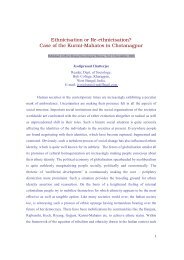1 Observing the normal Zeeman effect in transverse and longitudinal ...
1 Observing the normal Zeeman effect in transverse and longitudinal ...
1 Observing the normal Zeeman effect in transverse and longitudinal ...
You also want an ePaper? Increase the reach of your titles
YUMPU automatically turns print PDFs into web optimized ePapers that Google loves.
µ B µ = J<br />
(1)<br />
<br />
where<br />
e<br />
B =<br />
− 2m<br />
<br />
µ (2)<br />
e<br />
(μB = Bohr magnetron, me = mass of electron, e = elementary charge, = h/2π, h = Planck's<br />
constant).<br />
In an external magnetic field, B, <strong>the</strong> magnetic moment has <strong>the</strong> energy<br />
E = −µ<br />
B<br />
(3)<br />
The angular-momentum component <strong>in</strong> <strong>the</strong> direction of <strong>the</strong> magnetic field can have <strong>the</strong> values<br />
J z J<br />
J<br />
= M with M = J , J −1,....,<br />
−J<br />
(4)<br />
Therefore, <strong>the</strong> term with <strong>the</strong> angular momentum, J is split <strong>in</strong>to 2J + 1 equidistant <strong>Zeeman</strong><br />
components which differ by <strong>the</strong> value of MJ. The energy <strong>in</strong>terval of <strong>the</strong> adjacent components MJ,<br />
MJ+1 is<br />
∆ = µ B<br />
(5)<br />
E B<br />
We can observe <strong>the</strong> <strong>normal</strong> <strong>Zeeman</strong> <strong>effect</strong> e.g. <strong>in</strong> <strong>the</strong> red spectral l<strong>in</strong>e of cadmium (λ0 = 643.8 nm,<br />
f0 = 465.7 THz). It corresponds to <strong>the</strong> transition 1 D2 (J = 2, S = 0) → 1 P1 (J = 1, S = 0) of an<br />
electron of <strong>the</strong> fifth shell (see fig. 1). In <strong>the</strong> magnetic field, <strong>the</strong> 1 D2 level splits <strong>in</strong>to five <strong>Zeeman</strong><br />
components, <strong>and</strong> <strong>the</strong> level 1 P1 splits <strong>in</strong>to three <strong>Zeeman</strong> components hav<strong>in</strong>g <strong>the</strong> spac<strong>in</strong>g calculated<br />
us<strong>in</strong>g equation 5.<br />
Optical transitions between <strong>the</strong>se levels are only possible <strong>in</strong> <strong>the</strong> form of electrical dipole radiation.<br />
The follow<strong>in</strong>g selection rules apply for <strong>the</strong> magnetic quantum numbers MJ of <strong>the</strong> states <strong>in</strong>volved:<br />
∆<br />
M J<br />
⎧=<br />
± 1<br />
⎨<br />
⎩=<br />
0<br />
for σ components<br />
for π components<br />
Thus, we observe a total of three spectral l<strong>in</strong>es (see fig. 1); <strong>the</strong> π component is not shifted <strong>and</strong> <strong>the</strong><br />
two σ components are shifted by<br />
∆E<br />
∆ f = ±<br />
(7)<br />
h<br />
with respect to <strong>the</strong> orig<strong>in</strong>al frequency. In this equation, ΔE is <strong>the</strong> equidistant energy split calculated<br />
<strong>in</strong> equation 5.<br />
2<br />
(6)

















